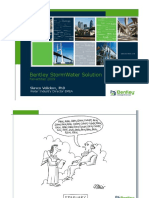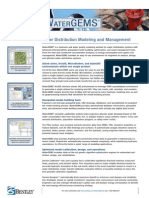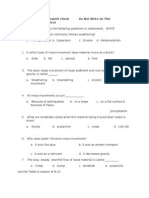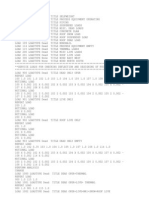Civil Storm
Civil Storm
Uploaded by
Badri SeetharamanCopyright:
Available Formats
Civil Storm
Civil Storm
Uploaded by
Badri SeetharamanCopyright
Available Formats
Share this document
Did you find this document useful?
Is this content inappropriate?
Copyright:
Available Formats
Civil Storm
Civil Storm
Uploaded by
Badri SeetharamanCopyright:
Available Formats
PRODUCT DATA SHEET
CivilStorm
Comprehensive Stormwater Modeling and Analysis
CivilStorm is a fully dynamic, multi-platform, hydraulic
modeling solution developed for the analysis of complex
stormwater systems. Engineers can analyze these systems
using built-in hydraulic and hydrology tools and a variety of
wet-weather calibration methods. From stormwater master
plan development to water quality studies, CivilStorm provides
an easy-to-use environment for engineers to analyze, design,
and operate stormwater systems.
One Solution for all Stormwater System Modeling Needs
CivilStorm performs comprehensive analysis of all aspects of stormwater
systems: rainfall, runoff, inlet capture and bypass, gravity and pressure piping,
ponds, outlet structures, open channels, culverts, and more.
Engineers can analyze pressure and free-surface flow conditions for networks
of channels and closed conduits; model complex pond outlets for a variety of
tailwater conditions; and use weirs, orifices, culverts, risers, and inlet boxes in
their design, all within a single product.
Model in Stand-alone or Within Favorite CAD Platform
CivilStorm works as a stand-alone application, or can be run from within
MicroStation or AutoCAD. Regardless of the platform used, CivilStorm maintains
a single set of modeling files for true interoperability across platforms, support for
multiple background layers, conversion utilities from CAD, GIS, and databases, and
unlimited undo and redo.
Map and model systems in a scaled environment whether the work is done in the
stand-alone, MicroStation, or AutoCAD interface.
Built-in Stormwater Hydrology
Engineers can load models with wet weather runoff flows derived from
precipitation using the CivilStorm built-in rainfall distributions, or user defined
rainfall events. Runoff flows are modeled using a choice of hydrograph methods,
including RTK, SCS, Modified Rational, EPA -SWMM, or user-defined generic
unit hydrographs.
CivilStorm can run from within MicroStation at no additional cost providing a
geospatial and engineering design environment with unrivaled visualization and
publishing tools. AutoCAD users can choose to add support to run CivilStorm
models from within AutoCAD, to build and lay out models with engineering
precision in an environment with which they are already comfortable.
Low Impact Development
Streamlined Model Building
Modelers can easily switch among multiple solvers, according to the type of
system they are analyzing.
Engineers can leverage geospatial data, CAD drawings, databases, and spreadsheets to jump-start the model building process. CivilStorm provides synchronized
database connections, geospatial links, and advanced model-building modules
that connect with virtually any digital data format. In addition, modelers can import
SWMM files as well as StormCAD files into CivilStorm. CivilStorm also provides
drawing and connectivity review tools to guarantee a hydraulically coherent model.
Easy Model Management with Scenarios
The Scenario Management Center in CivilStorm gives engineers full control to
configure, run, evaluate, visualize, and compare an unlimited number of scenarios
within a single file. Engineers can easily make decisions by comparing alternative
designs or proposed rehabilitation methods for a variety of system conditions
(including pre- and post-development).
6986_PDS_CivilStorm_LTR_0614.indd 1
CivilStorm can model the effect that low impact development controls have in
retaining runoff before it enters the stormwater system.
Multiple Solvers
To solve the Saint Venant equations, users can choose between CivilStorms
explicit EPA SWMM solver and the implicit dynamic wave engine. These two
dynamic engines account for storage effects within structures and quantify
flooding should it occur. Engineers can also use the SWMM water quality
features to comply with water quality regulations.
With the rational/gradually varied flow solver, peak flows in the storm sewer
system are calculated using the rational method. Use this solver to analyze
peak flow conditions, or to automatically design storm sewers.
For more information about the solvers supported by CivilStorm, download
What Is the Right Way to Analyze Collection System Hydraulics?
from www.bentley.com/SewerStormPaper.
6/20/2014 3:59:37 PM
System Requirements
CivilStorm At-A-Glance
Refer to the Installation Requirements
section of CivilStorms ReadMe file:
Interface and Graphical Editing
www.bentley.com/CivilStorm-Spec
Platform pre-requirements:
CivilStorm runs without platform
restrictions as a stand-alone
application.
It can also run from within AutoCAD
and MicroStation. The requirements
are also available in CivilStorms
ReadMe file.
Find out about Bentley
at: www.bentley.com
Contact Bentley
1-800-BENTLEY (1-800-236-8539)
Outside the US +1 610-458-5000
Global Office Listings
www.bentley.com/contact
Stand-alone Windows interface included
Ability to run within MicroStation (MicroStation license required)
Ability to run within PowerCivil for North America
(PowerCivil for North America license required)
Ability to run within AutoCAD (add-on option) (AutoCAD
license required)
InRoads Storm and Sanitary file import/export
MX Drainage file import
Unlimited undo and redo
Element morphing, splitting, and reconnection
Nodes in close proximity merging tool
Automatic element labeling
Scaled, schematic, and hybrid environments
Inference tool (to interpolate missing data)
Element prototypes (one-click setup)
Dynamic zooming
Named view
Aerial view
Multiple background file support
Image, CAD, and GIS background layer support
Automatic input and result fields filtering (based on solver used)
Interoperability and Model Building
Single set of model files for four compatible interfaces
GIS-ID property (to maintain associations between records in
source file and elements in model)
Polyline-to-pipe conversion from DXF and DWG files
Spreadsheet, database, Shapefile, and OleDB connections
Oracle spatial import/export
LandXML data import/export
SWMM files import
Observed data import
Time series data import
Automated assignment of elevation data to
manhole elements
Unified file format with SewerGEMS, SewerCAD, and StormCAD
Model Management
Unlimited scenarios and alternatives
Comprehensive scenario management
Scenario comparison
Active topology (to activate or deactivate network elements)
Tabular reports with global editing
Sorting and persistent filtering on tabular reports
Statistical analysis from tabular reports
Customizable engineering libraries
Dynamic (query based) and static selection sets
Element selection by polygon
Element selection inversion
Table opening on selection
Global engineering units management
Drawing review tools for connectivity consistency
Automatic topology review
Drawing navigator
Orphaned node and dead-end pipe queries
Custom data fields (with user-assigned or formulabased values)
Hyperlinks for network elements
Surface water flow direction displayed across any terrain
Support of ProjectWise and ProjectWise Geospatial Management
Hydraulics and Operations
Ability to switch readily between two engines for solving
the full set of St. Venant equations
Implicit dynamic engine included
Explicit dynamic engine included (EPA-SWMM)
Gradually varied flow-rational engine included
(StormCADs engine)
Steady-state simulations (peak flow)
Automatic constraint-based design for storm sewers
Long-term simulations with statistical reports
HEC-22 inlet capacity calculations
HEC-22 node headloss calculations
Support for V-shaped and parabolic gutters
Evaporation definition
Aquifer simulation
Pollution analysis with optional definition of land use
categories and land surface characteristics
Treatment analysis
Pond infiltration
Culvert roadway overtopping
Rule-based controls
Variable-speed pumping
Low impact development control analysis
Rainfall Data
Synthetic design storms or gauged events, including SCS
Types (I, IA, II, or III), Bulletin 71 rainfall, cumulative depth,
dimensionless depth (and depth and time), incremental
depth, and intensity hyetograph
Stormwater Load Allocation and Estimation
Runoff methods: SCS Unit Hydrograph, Modified Rational
Method, EPA SWMM, RTK Unit Hydrograph, generic
Unit Hydrograph, Time-Area Method, ILSAX and
user-defined hydrograph
Time of concentration methods: User-defined, Carter,
Eagleson, Espey/ Winslow, Federal Aviation Agency,
Kerby/Hathaway, Kirpich (PA and TN), Length and Velocity,
SCS Lag, TR-55 Sheet Flow, TR-55 Shallow Concentrated
Flow, TR-55 Channel Flow, Friend, Kinematic Wave,
Bransby-Williams, and UK standard
Loss Methods: Constant loss rate, Green and Ampt, Horton,
Initial Loss and Constant Fraction, Initial Loss and Constant
Loss Rate, SCS Curve Number
Inflow control center
PondMaker: Pond Outlet Design
Automatic update of worksheet containing design data
for multiple design trials of a single pond
Multiple pond designs possible
Maximum outflow rates establishment (user-defined
or pre-development flows)
Post-development pond inflows computation
Pond size requirements estimation
Pond geometry design (grading plan or
underground storage)
Outlet structure design
Pre- and post-development peak flow and
volume comparison
Hydrograph routing through ponds
Presentation of Results
Thematic mapping
Dynamic multi-parameter and multi-scenario graphing
Advanced dynamic profiling
Advanced tabular reporting with FlexTables
Property-based color coding and symbology
Property-based annotation
Contouring with Shapefile and DXF export
EQT (elevation vs. flow) curve to outfall element
Publishing of i-models in 2D or 3D, including to
Bentley Map Mobile
2014 Bentley Systems, Incorporated. Bentley, the B Bentley logo, FlexTables, InRoads, Loadbuilder, MicroStation, ProjectWise, SewerCAD, and SewerGEMS are
either registered or unregistered trademarks or service marks of Bentley Systems, Incorporated or one of its direct or indirect wholly owned subsidiaries. Other brands
and product names are trademarks of their respective owners. 6986 06/14
6986_PDS_CivilStorm_LTR_0614.indd 2
6/20/2014 3:59:38 PM
You might also like
- Proline 21 QuickreferenceDocument27 pagesProline 21 Quickreferencejump113100% (4)
- Cheat Pokemono Sword and SHield GBADocument3 pagesCheat Pokemono Sword and SHield GBAleandro lima90% (10)
- CAESAR II - Pipe Stress AnalysisDocument6 pagesCAESAR II - Pipe Stress Analysisnguyentrungsonctm7No ratings yet
- Xmas HitsDocument2 pagesXmas HitsHadjar MitmugNo ratings yet
- 4L4H / 4ft: Electrical DataDocument2 pages4L4H / 4ft: Electrical DataNoel Feliciano100% (1)
- Sewergems Product Data SheetDocument2 pagesSewergems Product Data SheetRyu Rey RogerNo ratings yet
- Sewercad en A4 SDocument2 pagesSewercad en A4 SsadhafzNo ratings yet
- Sewer Modeling Solutions: More Choices For You, More Time For EngineeringDocument8 pagesSewer Modeling Solutions: More Choices For You, More Time For Engineeringadera1No ratings yet
- Hammer Product Data SheetDocument2 pagesHammer Product Data SheetMisama NedianNo ratings yet
- Auto Desk Storm Sanitary Analysis 2015Document15 pagesAuto Desk Storm Sanitary Analysis 2015ByhiswillNo ratings yet
- NJB Stormcad Product Data SheetDocument2 pagesNJB Stormcad Product Data SheetBadri SeetharamanNo ratings yet
- Watercad Product Data Sheet PDFDocument2 pagesWatercad Product Data Sheet PDFElvis Yury Paucar CarrascoNo ratings yet
- Haestad All ProductsDocument22 pagesHaestad All ProductsopetcoNo ratings yet
- PDS SewerCAD LTR EN LR PDFDocument2 pagesPDS SewerCAD LTR EN LR PDFAmol KanadeNo ratings yet
- Watergems Product Data SheetDocument2 pagesWatergems Product Data SheetVinayak PotdarNo ratings yet
- Sewer GEMSDocument18 pagesSewer GEMSBoni ClydeNo ratings yet
- 3D Data CaptureDocument19 pages3D Data Capturem_925No ratings yet
- d6 - Bentley Storm Water SolutionDocument27 pagesd6 - Bentley Storm Water Solutionashe zinabNo ratings yet
- Valerio Steven Ce175-5w B2 CW5Document4 pagesValerio Steven Ce175-5w B2 CW5Steven ValerioNo ratings yet
- WaterGEMS GlanceDocument2 pagesWaterGEMS Glancesupriya2009No ratings yet
- Virtual HydraulicsDocument8 pagesVirtual Hydraulicsgplese0100% (1)
- Autodesk Storm Sanitary Analysis 2015 Tech CapabilitiesDocument15 pagesAutodesk Storm Sanitary Analysis 2015 Tech Capabilitiesedwin154No ratings yet
- SEWERGEMSDocument2 pagesSEWERGEMSyamen-691904No ratings yet
- Storm FeaturesDocument4 pagesStorm Featuresbem.05swNo ratings yet
- Watercad V8 XM EditionDocument20 pagesWatercad V8 XM EditionMarc PacoNo ratings yet
- Capabalities of WatergemsDocument3 pagesCapabalities of Watergemspravin mundeNo ratings yet
- MysepDocument16 pagesMysepsterling100% (1)
- Bentley AutoPIPE Product Data SheetDocument2 pagesBentley AutoPIPE Product Data Sheetalanoil666No ratings yet
- PDS StormCAD LTR EN LRDocument2 pagesPDS StormCAD LTR EN LRAndrea Santillan YzazagaNo ratings yet
- Bentley Autopipe V8: The Most Productive Tool For Pipe Stress AnalysisDocument2 pagesBentley Autopipe V8: The Most Productive Tool For Pipe Stress AnalysisputhenkulamNo ratings yet
- Water FeaturesDocument4 pagesWater Featuresbem.05swNo ratings yet
- Bentley Watercad Brosura PDFDocument2 pagesBentley Watercad Brosura PDFNeng RohmaNo ratings yet
- Haestad 20stormwater 20solutions 20pdfloDocument16 pagesHaestad 20stormwater 20solutions 20pdfloLionel Fernando Lujan AcuñaNo ratings yet
- Mike 11Document2 pagesMike 11Raluca Iustina0% (1)
- Introduction To Hec-Hms: Bill Scharffenberg Hydrologic Engineering CenterDocument30 pagesIntroduction To Hec-Hms: Bill Scharffenberg Hydrologic Engineering CentertilayeyidegNo ratings yet
- Bentley Sewergems Ds enDocument2 pagesBentley Sewergems Ds enRajesh Kumar MahanaNo ratings yet
- Water GemsDocument2 pagesWater GemsLidya TsegayeNo ratings yet
- Al-Rafa ProfileDocument11 pagesAl-Rafa ProfileAbhilekh VermaNo ratings yet
- AutoCAD Civil3D 2012 Storm Sanitary Analysis TechnicalCapabilitiesDocument18 pagesAutoCAD Civil3D 2012 Storm Sanitary Analysis TechnicalCapabilitiesswarluNo ratings yet
- Water MateDocument3 pagesWater MatejksabahNo ratings yet
- Bentley AutoPIPE V8iDocument2 pagesBentley AutoPIPE V8iAleksandar Stefanovic100% (1)
- 4-Hydraulic Modeling The Black ArtDocument101 pages4-Hydraulic Modeling The Black ArtRJN Group, Inc.100% (1)
- KYPipe Brochure 2007Document16 pagesKYPipe Brochure 2007bravo deltafox100% (1)
- WaterSolution Brochure 2014update LTR Screen enDocument8 pagesWaterSolution Brochure 2014update LTR Screen enMathiTwadCNo ratings yet
- Urban Drainage Utilities AUDocument2 pagesUrban Drainage Utilities AURodrigo Sánchez FerreiraNo ratings yet
- Caesar II BrochureDocument2 pagesCaesar II BrochurePrakhar KulshreshthaNo ratings yet
- Autocad Civil 3d 2012 Storm-Sanitary-Analysis BrochureDocument2 pagesAutocad Civil 3d 2012 Storm-Sanitary-Analysis Brochureshubham chikuNo ratings yet
- Mod FlowDocument6 pagesMod Flowapi-3850604No ratings yet
- JWC PDFDocument8 pagesJWC PDFJH_ProjectNo ratings yet
- Flow Master Users GuideDocument201 pagesFlow Master Users GuideRamiro TuzaNo ratings yet
- Wellplan Software: Key ValueDocument4 pagesWellplan Software: Key Valuebyed100% (1)
- InfoWorksWS Technical Review (En)Document5 pagesInfoWorksWS Technical Review (En)Anonymous c2ORcbNo ratings yet
- OpenFlows WaterGEMS - Product Data SheetDocument2 pagesOpenFlows WaterGEMS - Product Data SheetTejas R ShahNo ratings yet
- Software For Water Resource and Environmental EngineeringDocument11 pagesSoftware For Water Resource and Environmental EngineeringBawa Sheriff MohammedNo ratings yet
- Ventyx Minescape: Ventyx Intelligent Mining SolutionDocument26 pagesVentyx Minescape: Ventyx Intelligent Mining SolutionRizal Ma'rufiNo ratings yet
- PIPESIM Steady-State Multiphase Flow SimulatorDocument2 pagesPIPESIM Steady-State Multiphase Flow SimulatorClemenNo ratings yet
- Pipeline Real-time Data Integration and Pipeline Network Virtual Reality System: Digital Oil & Gas Pipeline: Research and PracticeFrom EverandPipeline Real-time Data Integration and Pipeline Network Virtual Reality System: Digital Oil & Gas Pipeline: Research and PracticeNo ratings yet
- Pipelined Processor Farms: Structured Design for Embedded Parallel SystemsFrom EverandPipelined Processor Farms: Structured Design for Embedded Parallel SystemsNo ratings yet
- Model-Driven Online Capacity Management for Component-Based Software SystemsFrom EverandModel-Driven Online Capacity Management for Component-Based Software SystemsNo ratings yet
- TIME SERIES FORECASTING. ARIMAX, ARCH AND GARCH MODELS FOR UNIVARIATE TIME SERIES ANALYSIS. Examples with MatlabFrom EverandTIME SERIES FORECASTING. ARIMAX, ARCH AND GARCH MODELS FOR UNIVARIATE TIME SERIES ANALYSIS. Examples with MatlabNo ratings yet
- Flow Simulation Using SOLIDWORKS 2023From EverandFlow Simulation Using SOLIDWORKS 2023No ratings yet
- StatemanDocument16 pagesStatemanBadri SeetharamanNo ratings yet
- 5 1157602207210668046 PDFDocument18 pages5 1157602207210668046 PDFBadri SeetharamanNo ratings yet
- Avenue Mail 6Document8 pagesAvenue Mail 6Badri SeetharamanNo ratings yet
- News PaperDocument16 pagesNews PaperBadri SeetharamanNo ratings yet
- Stateman PaperDocument16 pagesStateman PaperBadri SeetharamanNo ratings yet
- The Sikh Times5!1!17Document12 pagesThe Sikh Times5!1!17Badri SeetharamanNo ratings yet
- TheRamsBooks GeneralKnowledgeDocument115 pagesTheRamsBooks GeneralKnowledgeBadri SeetharamanNo ratings yet
- Company Profile Presentation Full ExportDocument45 pagesCompany Profile Presentation Full ExportBadri SeetharamanNo ratings yet
- SPAES SEA Summit 2011 Experience. Technology. Community. CommunityDocument11 pagesSPAES SEA Summit 2011 Experience. Technology. Community. CommunityBadri SeetharamanNo ratings yet
- Ration Card Member Addition (Birth) Application FormDocument1 pageRation Card Member Addition (Birth) Application FormBadri SeetharamanNo ratings yet
- Pop Up TemplateDocument3 pagesPop Up TemplatePragnakrishna Nallapaneni50% (2)
- EX OP P: by Robert Sabuda & Matthew ReinhartDocument3 pagesEX OP P: by Robert Sabuda & Matthew ReinhartBadri SeetharamanNo ratings yet
- 0908 PopUpCardWithButterfliesDocument2 pages0908 PopUpCardWithButterfliesBadri SeetharamanNo ratings yet
- Make A Pop-Up Valentine Card PDFDocument3 pagesMake A Pop-Up Valentine Card PDFBadri SeetharamanNo ratings yet
- Program Handouts Ready-MadeDocument5 pagesProgram Handouts Ready-MadeBadri SeetharamanNo ratings yet
- A Short Introduction To DSM (2016) : The Global Science-Based Company Active in Health, Nutrition and MaterialsDocument25 pagesA Short Introduction To DSM (2016) : The Global Science-Based Company Active in Health, Nutrition and MaterialsBadri SeetharamanNo ratings yet
- Waterlily Origami Pop-Up Card: MaterialsDocument1 pageWaterlily Origami Pop-Up Card: MaterialsBadri SeetharamanNo ratings yet
- Cold Storage Facilities For Horticulture Products: Press Information Bureau Government of India Ministry of AgricultureDocument2 pagesCold Storage Facilities For Horticulture Products: Press Information Bureau Government of India Ministry of AgricultureBadri SeetharamanNo ratings yet
- BBD Cold Weather Global 2012 2013Document12 pagesBBD Cold Weather Global 2012 2013OMENo ratings yet
- Mount Pinatubo Case Study ( Latest Eruption)Document3 pagesMount Pinatubo Case Study ( Latest Eruption)Kenneth D. LigutomNo ratings yet
- Ocean Wave DerivationsDocument64 pagesOcean Wave DerivationsDanielNo ratings yet
- Cross Drainage WorksDocument71 pagesCross Drainage Worksjahid shohag100% (2)
- Mass Movement Homework CheckDocument3 pagesMass Movement Homework CheckmrhensonNo ratings yet
- HD9-406-30 Antena Uhf OmnidireccionalDocument1 pageHD9-406-30 Antena Uhf OmnidireccionalhayashiedNo ratings yet
- BLACK CAT - Grader Blade Product Sheets - v6Document6 pagesBLACK CAT - Grader Blade Product Sheets - v6Anonymous xxFArUCSNo ratings yet
- MODULE 1 - Philippine Natural and Man Made DisastersDocument15 pagesMODULE 1 - Philippine Natural and Man Made DisastersayeyedumpNo ratings yet
- Runoff EstimatesDocument152 pagesRunoff EstimatesAnne Clarisse DionisioNo ratings yet
- 2 NeptuneDocument24 pages2 NeptuneFernando RamirezNo ratings yet
- Tripa de GallinaDocument68 pagesTripa de GallinaJake GallardoNo ratings yet
- Vision CSP23ET16QDocument18 pagesVision CSP23ET16QSagarNo ratings yet
- Staad Load Combinations With Notional LoadsREV3Document6 pagesStaad Load Combinations With Notional LoadsREV3ramonortiz55No ratings yet
- Wounds and InjuriesDocument15 pagesWounds and Injuriesaakash atteguppeNo ratings yet
- Prepared By: Alexander San AndresDocument28 pagesPrepared By: Alexander San AndresKenneth TolentinoNo ratings yet
- 01-Physical Setting Paper-2 NEWDocument87 pages01-Physical Setting Paper-2 NEWmanisNo ratings yet
- Bingo Card TyphoonDocument5 pagesBingo Card Typhoonmarco_pangilinanNo ratings yet
- Exercise 2 Bse Bahasa Inggris Kls 8 by GieDocument4 pagesExercise 2 Bse Bahasa Inggris Kls 8 by GieginanjarNo ratings yet
- Lesson 1 Volcano IntroductionDocument30 pagesLesson 1 Volcano IntroductionLena OrsolinoNo ratings yet
- Bush Craft NotesDocument5 pagesBush Craft Noteskins petetNo ratings yet
- SCIENCE 9 Process of Volcanic EruptionDocument31 pagesSCIENCE 9 Process of Volcanic EruptionmelvinliancabungcalNo ratings yet
- High 2 Students Book Answer KeyDocument19 pagesHigh 2 Students Book Answer KeyssNo ratings yet
- Contributions in The Understanding of Electricity and MagnetismDocument15 pagesContributions in The Understanding of Electricity and MagnetismgirllishlishNo ratings yet
- Leicestershirewildfowlersassociation - Co.uk - 974135383Document4 pagesLeicestershirewildfowlersassociation - Co.uk - 974135383Craig ParkinsonNo ratings yet
- Removable Insulation Jackets: Reference ListDocument42 pagesRemovable Insulation Jackets: Reference ListRebecca TerryNo ratings yet
- Ce 6001 Hydrology Question BankDocument4 pagesCe 6001 Hydrology Question BankShanmuga SundaramNo ratings yet











































































































